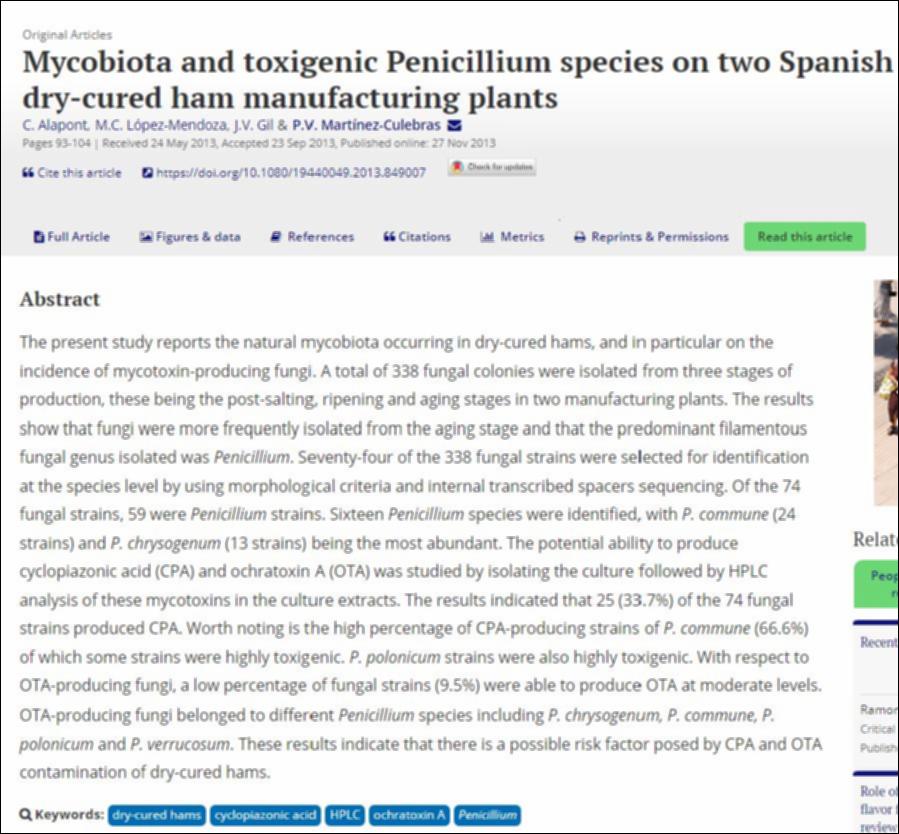Please use this identifier to cite or link to this item:
http://hdl.handle.net/10637/16286Mycobiota and toxigenic Penicillium species on two Spanish dry-cured ham manufacturing plants
| Title: | Mycobiota and toxigenic Penicillium species on two Spanish dry-cured ham manufacturing plants |
| Authors : | Alapont Gutiérrez, Cristina López Mendoza, María Carmen Gil Ponce, José Vicente Martínez Culebras, Pedro Vicente |
| Keywords: | Producto cárnico; Meat product; Ácido ciclopiazónico; Cyclopiazonic acid; Penicillium; Ochratoxin A; Química analítica; Analytical chemistry |
| Publisher: | Informa UK |
| Citation: | Alapont, C., López-Mendoza, M.C., Gil, J.V., & Martínez-Culebras, P.V. (2014). Mycobiota and toxigenic Penicillium species on two Spanish dry-cured ham manufacturing plants. Food Additives & Contaminants. Part A, Chemistry, Analysis, Control, Exposure and Risk Assessment, 31(1), 93–104. https://doi.org/10.1080/19440049.2013.849007 |
| Abstract: | The present study reports the natural mycobiota occurring in dry-cured hams, and in particular on the incidence of mycotoxin-producing fungi. A total of 338 fungal colonies were isolated from three stages of production, these being the post-salting, ripening and aging stages in two manufacturing plants. The results show that fungi were more frequently isolated from the aging stage and that the predominant filamentous fungal genus isolated was Penicillium. Seventy-four of the 338 fungal strains were selected for identification at the species level by using morphological criteria and internal transcribed spacers sequencing. Of the 74 fungal strains, 59 were Penicillium strains. Sixteen Penicillium species were identified, with P. commune (24 strains) and P. chrysogenum (13 strains) being the most abundant. The potential ability to produce cyclopiazonic acid (CPA) and ochratoxin A (OTA) was studied by isolating the culture followed by HPLC analysis of these mycotoxins in the culture extracts. The results indicated that 25 (33.7%) of the 74 fungal strains produced CPA. Worth noting is the high percentage of CPA-producing strains of P. commune (66.6%) of which some strains were highly toxigenic. P. polonicum strains were also highly toxigenic. With respect to OTA-producing fungi, a low percentage of fungal strains (9.5%) were able to produce OTA at moderate levels. OTA-producing fungi belonged to different Penicillium species including P. chrysogenum, P. commune, P. polonicum and P. verrucosum. These results indicate that there is a possible risk factor posed by CPA and OTA contamination of dry-cured hams. |
| Description: | Este recurso no está disponible en acceso abierto por política de la editorial. |
| URI: | http://hdl.handle.net/10637/16286 |
| Rights : | http://creativecommons.org/licenses/by-nc-nd/4.0/deed.es |
| ISSN: | 1944-0049 1944-0057 (Electrónico) |
| Issue Date: | Jan-2014 |
| Center : | Universidad Cardenal Herrera-CEU |
| Appears in Collections: | Dpto. Producción y Sanidad Animal, Salud Pública Veterinaria y Ciencia y Tecnología de los Alimentos |
Items in DSpace are protected by copyright, with all rights reserved, unless otherwise indicated.


